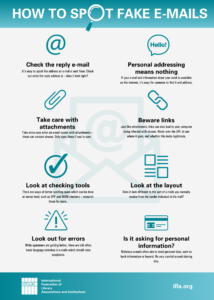IFLA releases “How to spot fake e-mails” infographic
08 November 2023
 Building on our popular How to Spot Fake News infographic, we are happy to release a new edition, focused on how to spot fake e-mail. This aims to give you tools you can use both to keep yourself – and your colleagues and users – safe online.
Building on our popular How to Spot Fake News infographic, we are happy to release a new edition, focused on how to spot fake e-mail. This aims to give you tools you can use both to keep yourself – and your colleagues and users – safe online.
While spam filters do a lot, we will all still be familiar with the phenomenon of potentially dangerous e-mails arriving in our inboxes. These are sometimes obvious, but sometimes less so, appearing to come from people we know.
They can, in particular, often encourage us to take urgent action, for example to transfer money. They can also include links or attachments which can contain viruses, or which try to get us to give up our passwords.
The person who’s e-mail is being faked can usually do nothing about it, and cannot be expected to know that this is happening. Instead, we must all be aware of what how to spot fake e-mail.
Our infographic offers eight simple tips, from spotting ‘spoofing’ (faking) of e-mail addresses, understanding that personal addressing doesn’t mean anything, taking care with attachments and links, using checking tools, looking for odd layouts and spellings, and being cautious about anything that asks for personal information.
You can download the infographic from our repository as an image file or in PDF.
Download
How to spot fake e-mails
A key aspect of how to stay safe online is the ability to spot scams that arrive in our inboxes. Building on the model of our popular How to spot fake news infographic, we are now sharing one on how to spot fake e-mail